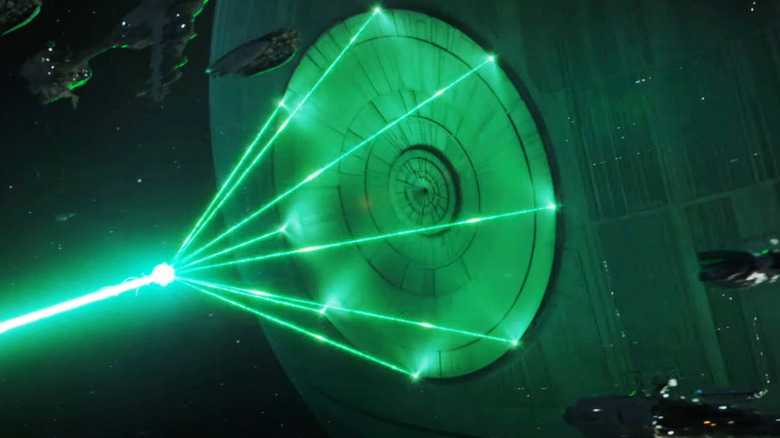Space Movies Lied To You About Lasers. Here's What They Got Wrong
Thanks to decades of Hollywood influence, when we think of lasers we typically think of laser beams. But this conception is actually quite misguided, as lasers need very specific circumstances in order to produce such beams — circumstances which space mostly doesn't provide.
As opposed to regular lights, laser lights emit a specific wavelength of visible light, whereby all of its light waves have the same or very similar wavelengths. As a result, rather than being white like your typical light bulb, a laser beam will be a specific color. Lasers are also highly concentrated. Whereas light bulbs will emit light in every direction, lasers constitute a single beam of concentrated light, often allowing lasers to burn or cut material. The light in a laser beam is also produced differently from typical light sources. In lasers, atoms are stimulated so as to excite their electrons, forcing the electrons to create photons, which ultimately leads to the creation of radiation and light. This is where the name "laser" actually comes from. It is an acronym for "light amplification by stimulated emission of radiation."
With all that in mind, if your knowledge of lasers only comes from movies, you'd likely expect all lasers to produce a visible beam that may or may not be extremely effective at felling aliens or almost slicing off James Bond's nether regions. In reality, however, not all lasers produce a visible beam all the time. If you've ever used a laser pen, for example, you'll recall that such a thing only produces a tiny red pinpoint of light. Why, then, are almost all lasers in movies depicted as producing very obvious beams? Because it looks cooler, that's why. But there's a very good reason why this depiction of lasers is basically one big lie — especially when it comes to movies set in space.
Laser beams come from light bouncing off particles in the air
Put simply, laser beams are created when photons bounce off particles in the air and are scattered or reflected by these particles. On Earth, we have dust particles in the air, but even that usually isn't enough to reveal a laser's beam. The aforementioned laser pens, for example, simply don't produce enough photons to bounce off these particles. More high-powered lasers will emit more photons, however, creating more possibilities for these photons to bounce off particles in the air. In these instances, you're more likely to see the beam of a laser.
By way of example, in 2022, green laser beams were seen in the sky and even captured on video, initially stumping observers who wondered what these mysterious lights might be. Soon, it was revealed that they came from a NASA satellite orbiting Earth which was beaming the lasers down to Earth to measure ice sheet elevation, sea ice thickness, and land topography. But what makes this incident instructive in this case is that the satellite's laser beams are usually very hard to see from the ground and can only be viewed when the light from the beams reflects off something. On September 16, 2022, when the green lights were captured on video, there were enough clouds in the sky to scatter the light, making the beams visible.
What does this have to do with sci-fi movies lying to us about lasers in space? Well, you might have already seen where this is going, but the near-vacuum of space doesn't exactly provide the perfect conditions for laser light to bounce off particles and become visible.
Lasers don't produce beams in space
Lasers have been a trope of sci-fi movie-making for decades. From the phasers of "Star Trek" to 007's mass laser battle in "Moonraker," we've been used to seeing these glowing beams of light in our space-based storytelling for what feels like forever. But unless these battles were taking place in areas of outer space full of cosmic dust, we shouldn't actually be able to see any of these beams firing back and forth.
The end of Earth's atmosphere is about 400 miles from the surface. Beyond that, the almost perfect vacuum of space means that there's very little matter, and the further you go, the less matter there is. The spaces between galaxies, for instance, contain about one atom per cubic meter, which isn't exactly ideal if you're trying to refract or scatter light. In these instances, seeing a laser beam is impossible — though it should be noted that space does contain some matter, from particles to energy, so if a laser were fired in an area dense with matter of this sort, you could conceivably see some sort of beam. Otherwise, the vacuum makes it impossible for beams to become visible, which means all those movies are essentially lying about how lasers would look out there in the cosmos.
Interestingly enough, in 2021, physicists at the University of Bonn, Germany announced they had developed a way for laser beams to become visible in a vacuum. The process was detailed in a paper published in Physical Review Applied, and it was a big step towards being able to align lasers with a degree of accuracy that can greatly help with quantum computing. So, that doesn't mean we'll be seeing "Star Wars"–style lasers bouncing around as humanity extends outward into the universe, but it is a neat and potentially hugely influential development in our understanding of quantum mechanics.


